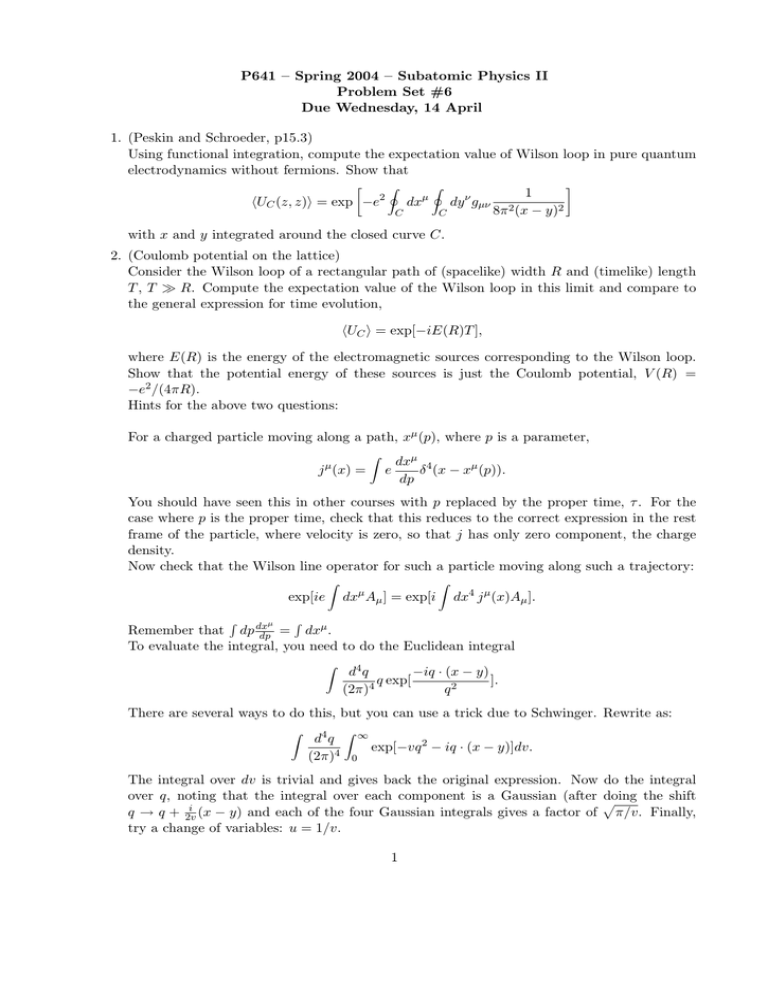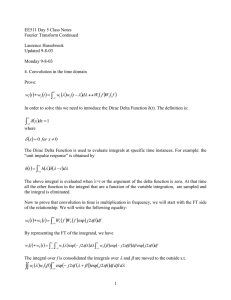P641 – Spring 2004 – Subatomic Physics II Problem Set #6 Due
advertisement

P641 – Spring 2004 – Subatomic Physics II Problem Set #6 Due Wednesday, 14 April 1. (Peskin and Schroeder, p15.3) Using functional integration, compute the expectation value of Wilson loop in pure quantum electrodynamics without fermions. Show that hUC (z, z)i = exp −e2 I dxµ I C dy ν gµν C 1 2 8π (x − y)2 with x and y integrated around the closed curve C. 2. (Coulomb potential on the lattice) Consider the Wilson loop of a rectangular path of (spacelike) width R and (timelike) length T , T R. Compute the expectation value of the Wilson loop in this limit and compare to the general expression for time evolution, hUC i = exp[−iE(R)T ], where E(R) is the energy of the electromagnetic sources corresponding to the Wilson loop. Show that the potential energy of these sources is just the Coulomb potential, V (R) = −e2 /(4πR). Hints for the above two questions: For a charged particle moving along a path, xµ (p), where p is a parameter, Z µ j (x) = e dxµ 4 δ (x − xµ (p)). dp You should have seen this in other courses with p replaced by the proper time, τ . For the case where p is the proper time, check that this reduces to the correct expression in the rest frame of the particle, where velocity is zero, so that j has only zero component, the charge density. Now check that the Wilson line operator for such a particle moving along such a trajectory: Z exp[ie µ Z µ dx Aµ ] = exp[i dx4 j µ (x)Aµ ]. µ Remember that dp dx dp = dx . To evaluate the integral, you need to do the Euclidean integral R R Z −iq · (x − y) d4 q q exp[ ]. (2π)4 q2 There are several ways to do this, but you can use a trick due to Schwinger. Rewrite as: Z d4 q (2π)4 Z ∞ exp[−vq 2 − iq · (x − y)]dv. 0 The integral over dv is trivial and gives back the original expression. Now do the integral over q, noting that the integral over each component is a Gaussian (after p doing the shift i q → q + 2v (x − y) and each of the four Gaussian integrals gives a factor of π/v. Finally, try a change of variables: u = 1/v. 1 3. (Reading assignment: Physics Today article) Read the article from Physics Today (with one of our own, Steve Gottlieb, as a coauthor). Briefly give your opinion about the value of funding large scale coputing facilities for use by the major lattice gauge collaboration. You won’t lose points for your opinion, but you could for faulty reasoning! Consider issues like contribution of this effort to the computing infrastructure of the U.S. 2


